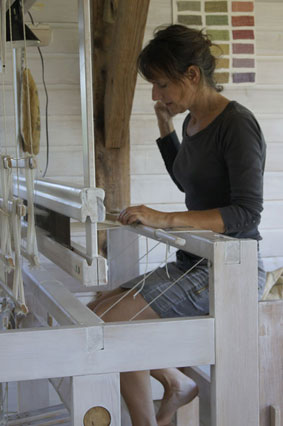My work evolves but I am always drawn back to where I started with my interest in archaeology, and a fascination for early textiles. Examining some faded fragments in the V and A, I am aware of hands that had processed wool, nettle, linen into fibres to be spun, and of the hours spent at the loom to produce a small quantity of cloth. Textiles must have been valued more than in the machine age, each piece being put to good use, gradually being cut down and re-used, before returning to the earth. My work is varied but I try to achieve a sense of earth, stone, vegetation, and decomposition. Some pieces are woven in the coarsest of textures, some are small and finely woven, sewn together into larger form; some remain forever fragments. The use of hand-spun nettle and antique linen yarn, that in its unevenness still retains traces of life, gives an essential ‘clothiness’ to my work that I do not find in machine spun yarn. Perhaps unconsciously searching for something human and elemental, I react to living in this age of the fast and disposable that vies with our need to sustain resources.
Apart from my family, weaving has been my main occupation, and preoccupation, for more than twenty years, yet, if asked what my intentions are I find it difficult to explain perhaps because explanations risk sounding pretentious. My work evolves. I go away from what I want, but I always seem to return to when I began to weave through my study of prehistoric textiles and interest in archaeology.
Practising spinning nettle yarn with a distaff I am struck what a human thing it is to make cloth from bits of organic fibre, and how time consuming it is to weave even a small amount. Cloth must have been much more valued than it is now, being cut down as it wore away until only patches remained to be sewn together into new form. I like the act of weaving, the slowness of its growth, the feel of the yarn in my fingers. Looking backwards to what was made by hand rather than machine I appreciate the slow carefulness that must have been employed in the making of essential artefacts..
My weavings contain many influences besides those of ancient textiles that have survived the millennia: I find beauty in the ruins of what once must have been new: the patterns in damp and crumbling plaster; the remains of paint on decayed wood; rotting bark; broken carvings; fallen monoliths.
Some of these I express in broken borders, insets and slits; twining and wrapping; weaves of herringbone and twill; mends, darns, frayings; drawn threads and slits. Disintegration and destruction. My work is unplanned. I weave as I reflect: some pieces are coarse and as wide as my loom allows, others are fine and small, to be sewn together later into larger form.
Some I leave as fragments, which I have always had a liking for. These have a beauty of their own: in that sense they are entire in themselves, in another they remain a suggestion of something greater.
Besides using nettle yarn, I work in hand-spun, unbleached linen, sometimes adding small amounts of silk. The ‘clothiness’ of my work, the way it shimmers in certain lights, and the unevenness of the yarn which gives it texture and life, is satisfying to me.
If all creativity stems from dissatisfaction, maybe for me it is a dissatisfaction with the ugliness of much that is modern, and the ruin of what I imagine once to have been beautiful, but despite my weaving having roots in the past, I look forward to a future where we do not discard things because they are worn out or outmoded. Out of decay and disintegration I wish to express a sense of renewal.

Please follow us on our instagram page by clicking here.
